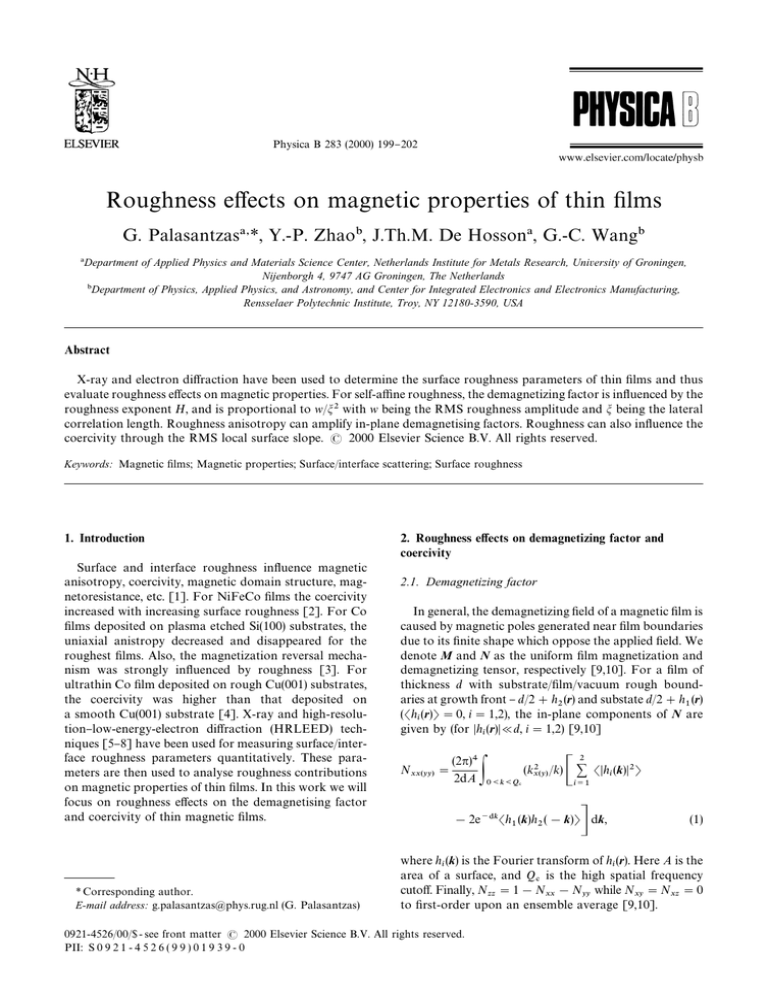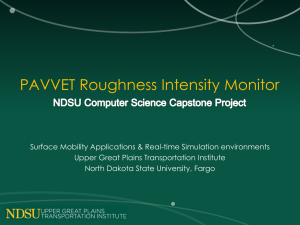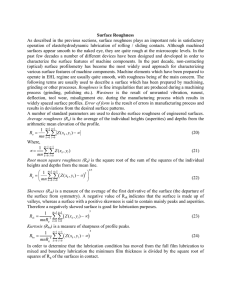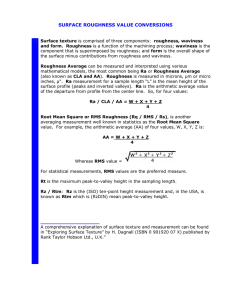
Physica B 283 (2000) 199}202
Roughness e!ects on magnetic properties of thin "lms
G. Palasantzas *, Y.-P. Zhao, J.Th.M. De Hosson , G.-C. Wang
Department of Applied Physics and Materials Science Center, Netherlands Institute for Metals Research, University of Groningen,
Nijenborgh 4, 9747 AG Groningen, The Netherlands
Department of Physics, Applied Physics, and Astronomy, and Center for Integrated Electronics and Electronics Manufacturing,
Rensselaer Polytechnic Institute, Troy, NY 12180-3590, USA
Abstract
X-ray and electron di!raction have been used to determine the surface roughness parameters of thin "lms and thus
evaluate roughness e!ects on magnetic properties. For self-a$ne roughness, the demagnetizing factor is in#uenced by the
roughness exponent H, and is proportional to w/m with w being the RMS roughness amplitude and m being the lateral
correlation length. Roughness anisotropy can amplify in-plane demagnetising factors. Roughness can also in#uence the
coercivity through the RMS local surface slope. 2000 Elsevier Science B.V. All rights reserved.
Keywords: Magnetic "lms; Magnetic properties; Surface/interface scattering; Surface roughness
1. Introduction
Surface and interface roughness in#uence magnetic
anisotropy, coercivity, magnetic domain structure, magnetoresistance, etc. [1]. For NiFeCo "lms the coercivity
increased with increasing surface roughness [2]. For Co
"lms deposited on plasma etched Si(100) substrates, the
uniaxial anistropy decreased and disappeared for the
roughest "lms. Also, the magnetization reversal mechanism was strongly in#uenced by roughness [3]. For
ultrathin Co "lm deposited on rough Cu(001) substrates,
the coercivity was higher than that deposited on
a smooth Cu(001) substrate [4]. X-ray and high-resolution}low-energy-electron di!raction (HRLEED) techniques [5}8] have been used for measuring surface/interface roughness parameters quantitatively. These parameters are then used to analyse roughness contributions
on magnetic properties of thin "lms. In this work we will
focus on roughness e!ects on the demagnetising factor
and coercivity of thin magnetic "lms.
* Corresponding author.
E-mail address: g.palasantzas@phys.rug.nl (G. Palasantzas)
2. Roughness e4ects on demagnetizing factor and
coercivity
2.1. Demagnetizing factor
In general, the demagnetizing "eld of a magnetic "lm is
caused by magnetic poles generated near "lm boundaries
due to its "nite shape which oppose the applied "eld. We
denote M and N as the uniform "lm magnetization and
demagnetizing tensor, respectively [9,10]. For a "lm of
thickness d with substrate/"lm/vacuum rough boundaries at growth front } d/2#h (r) and substate d/2#h (r)
(1h (r)2"0, i"1,2), the in-plane components of N are
G
given by (for "h (r)"d, i"1,2) [9,10]
G
(2p)
N
"
VVWW
2dA
I/
(k /k)
VW
1"h (k)"2
G
G
!2e\I1h (k)h (!k)2 dk,
(1)
where h (k) is the Fourier transform of h (r). Here A is the
G
G
area of a surface, and Q is the high spatial frequency
cuto!. Finally, N "1!N !N while N "N "0
XX
VV
WW
VW
VX
to "rst-order upon an ensemble average [9,10].
0921-4526/00/$ - see front matter 2000 Elsevier Science B.V. All rights reserved.
PII: S 0 9 2 1 - 4 5 2 6 ( 9 9 ) 0 1 9 3 9 - 0
200
G. Palasantzas et al. / Physica B 283 (2000) 199}202
[5}8,17]. A simple self-a$ne model in Fourier space
[15,16] reads of the form
2.2. Coercivity
We denote H as the coercive "eld and d the domain
wall width. Following Soohoo and Middelhoek [11,12],
we treat the coercivity H for a single rough boundary
and a straight wall moving parallel to itself as [13,14]
1 *E
E
# o ;
H "
2M *d
d
(2p) /
k1"h(k)"2dk
,
(2)
A
/B
where the domain energy is E and the thickness #uctu
ations are represented by the local surface slope
o "(1
h2 [15,16]. Q "p/a with a being the
order of an atomic spacing, and Q "2p/d. For a Neel
B
wall, E "A (p/d)K (d/2)#pM dd/(d#d). A "JS/a
is the exchange constant (J"155 K and a is an atomic
length scale), and S the average spin ((0.65 for
d(10 nm) [8]. K "K #(2K /d) is the in-plane an
isotropy constant with K and K being the in-plane
volume and surface anisotropy constants, respectively
[11,12].
o "
A
3. Roughness models
A
wm
1"h(k)"2"
;
(2p) (1#akm)>&
1
[1!(1#aQm)\&],
a"
2H
(3)
which will be used to calculate the demagnetizing factor
and coercivity (Eqs. (1) and (2)).
3.2. Roughness for linear growth fronts
Stable linear growth fronts [18] are described by
Langevin equations *h(r, t)/*t"v
h(r, t)!K
h(r, t)#
g(r, t) with g(r, t) being a Gaussian noise of amplitude D.
The parameter i is proportional to the surface di!usion
coe$cient, and v is proportional to surface tension which
is the result of the evaporation/recondensation process.
Solution of this linear equation yields [18]
1"h (k, t)"2"e*IR1"h (k, t)"2#(4p)[A/(2p)]
;D(e*IR!1)¸(k)\.
(4)
1h (k, t)h (!k, t)2"e*IR1"h (k, t)"2,
¸(k)"!vk!ik.
Our calculations or roughness e!ects are performed
for self-a$ne rough surfaces observed in magnetic "lms
[3,4,17] and rough growth fronts based on linear Langevin equations [18].
For v'0 and i"0 we obtain H"0, while for v"0
and i'0 we have H"1. For v(0, Eq. (4) describes
intitial stages of unstable growing surfaces [18].
3.1. Roughness for self-azne fronts
4. Results and discussions
Isotropic self-a$ne roughness is characterized by the
RMS roughness amplitude w, the lateral in-pnane correlation length m, and the roughness exponent
H(0(H(1) which characterize the degree of surface
irregularity at short roughness wavelengths ((m)
4.1. Demagnetizing factor
For simplicity, we will present results mainly for "lms
with a single rough boundary. As shown in Fig. 1(a), for
a self-a$ne surface, N
is strongly a!ected by the
VVWW
Fig. 1. (a) N versus H for d"90 nm, m"200 nm and w"1 nm. (b) N versus growth time t with F/D"200 and F the average
VV
VV
deposition rate (d"Ft). (c) N versus t for unstable growth.
VV
G. Palasantzas et al. / Physica B 283 (2000) 199}202
roughness exponent H and to a leading order is proportional to w/m [15}17]. Extending Eq. (3) for surfaces
with correlation length anisotropy 1"h(k)"2Jm m /
V W
(1#km #km)>&, it can be shown that N /N J
V V
W W
VV WW
(m /m )A where c"1.7 [9,10] suggesting that roughness
W V
anisotropy can amplify the demagnetizing factors drastically.
We also examine the evolution of N
with thickVVWW
ness or alternatively growth time t for "lms grown on
a smooth substrate (h "0) with linear mechanism. Fig.
1(b) indicates that N
scales as N
Jt\C with
VVWW
VVWW
e+2b!b/H!1. b is the growth exponent such that
wJt@ and mJt&@ [5}8,17]. For v"0 and i"1 we
obtain numerically e"0.75, while the model solution
yields the consistent result e+2b!b/H!1"3/4
(H"1, b"1/4). For v"100 and i"0, N
is larger
VVWW
than for v"0 and i"1, since the former corresponds to
H"0 and the later corresponds to H"1 [5}8,17]. For
v(0 (unstable growth; Schowebel barrier e!ect) [18]
a drastic increase of N
occurs at later stages of
VVWW
growth due to strong roughening, see Fig. 1(c).
4.2. Coercivity
For the Co "lms deposited on Cu(001), the roughness
parameters w, H, and m were determined by HRLEED
[4]. Fig. 2 shows o d (arrow pointing on the left),
where roughening of the Co "lms is evident since o in
creases almost one order of magnitude for 2)d)25
ML. Experimentally, H increased up to &80 Oe at
d}7 ML, and then slightly decreased and approached
saturation [4]. Using K "!2.3;10 erg/cm, a "
0.25 nm [11,12], S"0.05, K "0.034 erg/cm, M "
1400 emu, and wall thickness d}5 nm [13,14], H can be
calculated as shown in Fig. 2 (arrow pointing on the
right). For an FCC lattice (which is close to the FCT
Co/Cu(001) growth lattice), the variation of M with "lm
201
thickness d is given by [19]
M(d)/M "1!(k ¹/16pSG J) f (d), f (d)
" C [ln(1!e\ )!ln(1!e\)],
H A"(16JS/k ¹)[+1!p/4G,!+1#p/4G,cos k ],
B"(16JS/k ¹)[+1!p/4,!+1#p/4,cos k ],
C "(1#cos k )\
(5)
with G "d/a , k "2pj /G and G*10. The calcu
M lated coersivity at &15 ML is close to the experimental
data for the Co [4] "lms, &120 Oe, and decreases slightly
for further increase of the "lm thickness, see Fig. 2.
5. Conclusions
Surface/interface roughness and thin "lm growth
mechanisms can have strong in#uence on magnetic properties of thin "lms. Therefore, a precise determination of
"lm roughness as well as its growth mechanism using
X-ray and electron di!raction stands as a necessary step
to correlate microstructural disorder with magnetic
properties. We have worked out theoretically that the
knowledge of demagnetizing factor N
allows more
VVWW
precise determination of roughness e!ects on coercivity,
domain wall width, and domain sizes.
Acknowledgements
Work at Rensselaer Polytechnic Institute was supported by NSF.
References
Fig. 2. Average local slope o
(squares; calculated from the
experimental data in Ref. [4].) and coercivity H (circles) versus
thickness d for Co "lms deposited on Cu(001).
[1] J.A.C. Bland, B. Heinrich (Eds.), Ultrathin Magnetic Structures I and II, Springer, New York, 1994.
[2] V.I. Malyutin et al., Phys Status Solid A 65 (1981) 45.
[3] M. Li, G.-C. Wang, H.-G. Min, J. Appl. Phys. 83 (1998)
5313.
[4] Q. Jiang, H.-N. Yang, G.-C. Wang, Surf. Sci. 373 (1997)
181.
[5] S.K. Sinha et al., Phys. Rev. B 38 (1988) 2297.
[6] V. Holy et al., Phys. Rev. B 47 (1993) 15 896.
[7] D.K.G. de Boer, Phys. Rev. B 53 (1996) 6048.
[8] H.-N. Yang, G.-C. Wang, T.-M. Lu, Di!raction from
Rough Surfaces and Dynamic Growth Fronts, World
Scienti"c, Singapore, 1993.
[9] Y.-P. Zhao, G. Palasantzas, G.-C. Wang, J.Th.M. De Hosson, Phys. Rev. B 60 (1999) 1216.
[10] G. Palasantzas, J. Appl. Phys. 86 (1999) 2196.
[11] R.F. Soohoo, J. Appl. Phys. 52 (1981) 2461.
202
G. Palasantzas et al. / Physica B 283 (2000) 199}202
[12] G. Drukerij Wed, N.V. Van Soest, S. Middelhoeok, (Eds.),
Ferromagnetic Domains in Thin Ni}Fe Films, Amsterdam,
1961.
[13] Y.-P. Zhao, G. Palasantzas, G.-C. Wang, J.Th.M. De
Hosson, in preparation.
[14] G. Palasantzas, Phys. Rev. E 56 (1997) 1254.
[15]
[16]
[17]
[18]
G. Palasantzas, Phys. Rev. B 48 (1993) 14 472.
G. Palasantzas, Phys. Rev. B 49 (1994) E5785.
J. Krim, G. Palasantzas, Int. J. Mod. Phys. B 9 (1995) 599.
Y.-P. Zhao, H.-Y. Yang, G.-C. Wang, T.-M. Lu, Phys. Rev.
B 57 (1998) 1922.
[19] S.J. Glass, M.J. Klein, Phys. Rev. 109 (1958) 288.





